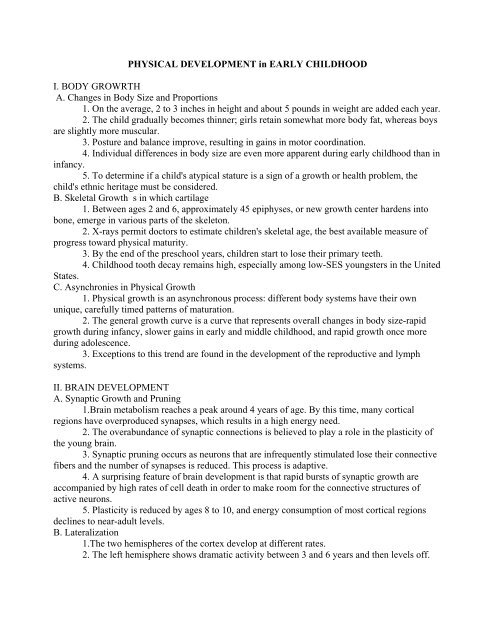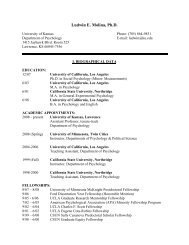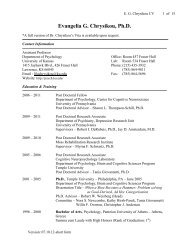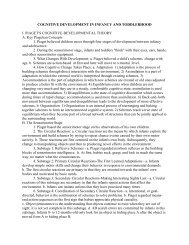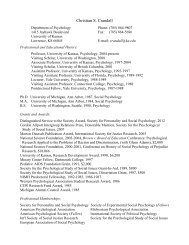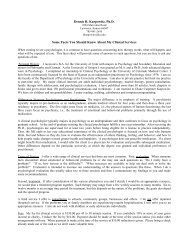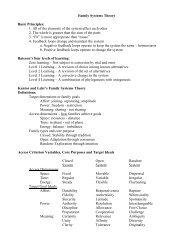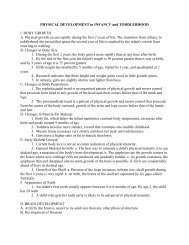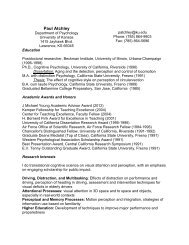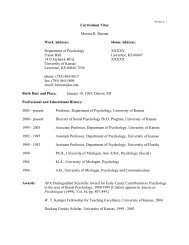PHYSICAL DEVELOPMENT in EARLY CHILDHOOD I. BODY ...
PHYSICAL DEVELOPMENT in EARLY CHILDHOOD I. BODY ...
PHYSICAL DEVELOPMENT in EARLY CHILDHOOD I. BODY ...
You also want an ePaper? Increase the reach of your titles
YUMPU automatically turns print PDFs into web optimized ePapers that Google loves.
<strong>PHYSICAL</strong> <strong>DEVELOPMENT</strong> <strong>in</strong> <strong>EARLY</strong> <strong>CHILDHOOD</strong><br />
I. <strong>BODY</strong> GROWRTH<br />
A. Changes <strong>in</strong> Body Size and Proportions<br />
1. On the average, 2 to 3 <strong>in</strong>ches <strong>in</strong> height and about 5 pounds <strong>in</strong> weight are added each year.<br />
2. The child gradually becomes th<strong>in</strong>ner; girls reta<strong>in</strong> somewhat more body fat, whereas boys<br />
are slightly more muscular.<br />
3. Posture and balance improve, result<strong>in</strong>g <strong>in</strong> ga<strong>in</strong>s <strong>in</strong> motor coord<strong>in</strong>ation.<br />
4. Individual differences <strong>in</strong> body size are even more apparent dur<strong>in</strong>g early childhood than <strong>in</strong><br />
<strong>in</strong>fancy.<br />
5. To determ<strong>in</strong>e if a child's atypical stature is a sign of a growth or health problem, the<br />
child's ethnic heritage must be considered.<br />
B. Skeletal Growth s <strong>in</strong> which cartilage<br />
1. Between ages 2 and 6, approximately 45 epiphyses, or new growth center hardens <strong>in</strong>to<br />
bone, emerge <strong>in</strong> various parts of the skeleton.<br />
2. X-rays permit doctors to estimate children's skeletal age, the best available measure of<br />
progress toward physical maturity.<br />
3. By the end of the preschool years, children start to lose their primary teeth.<br />
4. Childhood tooth decay rema<strong>in</strong>s high, especially among low-SES youngsters <strong>in</strong> the United<br />
States.<br />
C. Asynchronies <strong>in</strong> Physical Growth<br />
1. Physical growth is an asynchronous process: different body systems have their own<br />
unique, carefully timed patterns of maturation.<br />
2. The general growth curve is a curve that represents overall changes <strong>in</strong> body size-rapid<br />
growth dur<strong>in</strong>g <strong>in</strong>fancy, slower ga<strong>in</strong>s <strong>in</strong> early and middle childhood, and rapid growth once more<br />
dur<strong>in</strong>g adolescence.<br />
3. Exceptions to this trend are found <strong>in</strong> the development of the reproductive and lymph<br />
systems.<br />
II. BRAIN <strong>DEVELOPMENT</strong><br />
A. Synaptic Growth and Prun<strong>in</strong>g<br />
1.Bra<strong>in</strong> metabolism reaches a peak around 4 years of age. By this time, many cortical<br />
regions have overproduced synapses, which results <strong>in</strong> a high energy need.<br />
2. The overabundance of synaptic connections is believed to play a role <strong>in</strong> the plasticity of<br />
the young bra<strong>in</strong>.<br />
3. Synaptic prun<strong>in</strong>g occurs as neurons that are <strong>in</strong>frequently stimulated lose their connective<br />
fibers and the number of synapses is reduced. This process is adaptive.<br />
4. A surpris<strong>in</strong>g feature of bra<strong>in</strong> development is that rapid bursts of synaptic growth are<br />
accompanied by high rates of cell death <strong>in</strong> order to make room for the connective structures of<br />
active neurons.<br />
5. Plasticity is reduced by ages 8 to 10, and energy consumption of most cortical regions<br />
decl<strong>in</strong>es to near-adult levels.<br />
B. Lateralization<br />
1.The two hemispheres of the cortex develop at different rates.<br />
2. The left hemisphere shows dramatic activity between 3 and 6 years and then levels off.
3. Activity <strong>in</strong> the right hemisphere <strong>in</strong>creases slowly throughout early and middle childhood,<br />
show<strong>in</strong>g a slight spurt between ages 8 and 10.<br />
4. Differences <strong>in</strong> rate of development of the two hemispheres suggest that they are<br />
cont<strong>in</strong>u<strong>in</strong>g to lateralize .<br />
C. Handedness<br />
1.By age 2, hand preference is fairly stable, and it strengthens dur<strong>in</strong>g early and middle<br />
childhood.<br />
2. The dom<strong>in</strong>ant cerebral hemisphere is the hemisphere responsible for skated motor action.<br />
The left hemisphere is dom<strong>in</strong>ant <strong>in</strong> right-handed <strong>in</strong>dividuals. In left-handed <strong>in</strong>dividuals, motor and<br />
language skills are often shared between the hemispheres.<br />
3. The bra<strong>in</strong>s of left-handers tend to be less strongly lateralized than those of right-handers.<br />
Many left-handers are ambidextrous.<br />
4. New evidence <strong>in</strong>dicates that the way most fetuses lie <strong>in</strong> the uterus-turned toward the leftmay<br />
promote greater postural control by the right side of the body.<br />
5. Left and mixed-handed children are more likely than their right-handed age mates to<br />
develop outstand<strong>in</strong>g verbal and mathematical talents.<br />
D. Other Advances <strong>in</strong> Bra<strong>in</strong> Development<br />
1. The cerebellum is located at the rear and base of the bra<strong>in</strong> and aids <strong>in</strong> balance and control<br />
of body movement.<br />
2. The fibers l<strong>in</strong>k<strong>in</strong>g the cerebellum to the cerebral cortex do not complete myel<strong>in</strong>ization<br />
until about age 4.<br />
3. The reticular formation ma<strong>in</strong>ta<strong>in</strong>s alertness and consciousness; it myel<strong>in</strong>ates throughout<br />
early childhood and cont<strong>in</strong>ues growth <strong>in</strong>to adolescence.<br />
4. The corpus callosum is the large bundle of fibers that connects the left and right<br />
hemispheres. Myel<strong>in</strong>ization does not beg<strong>in</strong> until the end of the first year of life, but is fairly<br />
advanced by age 4 to 5.<br />
III. FACTORS AFFECTING GROWTH AND HEALTH<br />
A. Heredity and Hormones<br />
1. Children's physical size and rate of growth are related to that of their parents.<br />
2. The pituitary gland is a gland located near the base of the bra<strong>in</strong> that releases hormones<br />
affect<strong>in</strong>g physical growth. a. Growth hormone affects the development of almost all body tissues,<br />
except the central nervous system and the genitals. Short children with GH deficiency can be<br />
treated with <strong>in</strong>jections of genetically eng<strong>in</strong>eered GH. b. Thyroid stimulat<strong>in</strong>g hormone stimulates<br />
the thyroid gland to release thyrox<strong>in</strong>e, which is necessary for normal bra<strong>in</strong> development and body<br />
growth.<br />
B. Emotional Well-Be<strong>in</strong>g<br />
1. Preschoolers with very stressful home lives suffer more respiratory and <strong>in</strong>test<strong>in</strong>al<br />
illnesses, as well as un<strong>in</strong>tentional <strong>in</strong>juries.<br />
2. Deprivation dwarfism is a growth disorder observed between 2 and 15 years of age that is<br />
caused by emotional deprivation. It is characterized by very short stature, weight that is usually<br />
appropriate for height, immature skeletal age, and decreased GH secretion.<br />
C. Sleep Habits and Problems<br />
1. Sleep contributes to body growth, s<strong>in</strong>ce GH is released dur<strong>in</strong>g sleep<strong>in</strong>g hours.<br />
2. Total sleep decl<strong>in</strong>es from 12 to 13 hours at ages 2 and 3 to 10 to 11 hours at ages 4 to 6.
3. Bedtime rituals, such as us<strong>in</strong>g the toilet, listen<strong>in</strong>g to a story, and kiss<strong>in</strong>g before turn<strong>in</strong>g<br />
off the light, help Western preschoolers adjust to be<strong>in</strong>g left by themselves <strong>in</strong> a darkened room.<br />
4. Almost all children beg<strong>in</strong> to have a few nightmares between ages 3 to 6.<br />
5. About 15% of preschoolers experience difficulty fall<strong>in</strong>g and stay<strong>in</strong>g asleep. Family stress<br />
can also prompt childhood sleep disturbances.<br />
D. Nutrition<br />
1. Preschoolers' appetites decrease because growth has slowed.<br />
2. <strong>in</strong> addition, they become picky eaters. This is adaptive as young children are still learn<strong>in</strong>g<br />
which items are safe to eat and which are not.<br />
3. Because caloric <strong>in</strong>take is reduced, preschoolers need a high-quality diet.<br />
4. The social environment and emotional climate at mealtimes have a powerful impact on<br />
children's eat<strong>in</strong>g habits.<br />
5. Insufficient amounts of iron, calcium, vitam<strong>in</strong> C, and vitam<strong>in</strong> A are the most common<br />
diet deficiencies of the preschool years.<br />
6. By age 71 low-SES children <strong>in</strong> the United States are, on the average, about 1 <strong>in</strong>ch shorter<br />
than their middle-class counterparts.<br />
E. Infectious Disease<br />
1. Infectious Disease and Malnutrition: a. In well-nourished children, ord<strong>in</strong>ary childhood<br />
illnesses have no effect on physical growth. b. In develop<strong>in</strong>g nations, many children do not receive<br />
a program of immunizations. c. Disease is a major cause of malnutrition, and, through it, affects<br />
physical growth. d. Most growth retardation and deaths due to diarrhea <strong>in</strong> develop<strong>in</strong>g countries can<br />
be prevented with oral rehydration therapy , <strong>in</strong> which sick children are given a glucose, salt, and<br />
water solution that replaces lost body fluids.<br />
2. Immunization: a. Although the majority of preschoolers <strong>in</strong> the United States are<br />
immunized, some do not receive full protection until 5 or 6 years of age, when it is required for<br />
school entry. b. Immunization rates <strong>in</strong> the U.S. have improved, but are still beh<strong>in</strong>d those of other<br />
Western nations.<br />
3. Day Care and Infectious Disease: a. Research <strong>in</strong> Europe and the U.S. <strong>in</strong>dicates that<br />
childhood illness rises with day care attendance. b. By age 3, over 70% of children <strong>in</strong> day care have<br />
at least one bout of otitis media, or middle ear <strong>in</strong>fection. c. Research <strong>in</strong>dicates that frequent otitis<br />
media predicts delayed language progress, social isolation <strong>in</strong> early childhood, and poorer academic<br />
performance after school entry.<br />
F. Childhood Injuries<br />
1. Auto accidents, drown<strong>in</strong>gs, and burns are the most common <strong>in</strong>juries dur<strong>in</strong>g early<br />
childhood.<br />
2. Motor vehicle collisions are the lead<strong>in</strong>g cause of death among children over I year of age.<br />
3. Factors Related to Childhood Injuries: a. As with other aspects of development, <strong>in</strong>juries<br />
take place with<strong>in</strong> a complex ecological 5ystem. b. Because of their higher activity level and greater<br />
will<strong>in</strong>gness to take risks dur<strong>in</strong>g play, boys are more likely to be <strong>in</strong>jury victims than girls. c.<br />
Irritability, <strong>in</strong>attentiveness, and negative mood are also related to childhood <strong>in</strong>juries. d. Poverty and<br />
low parental education are strongly associated with <strong>in</strong>jury deaths. e. Among Western <strong>in</strong>dustrialized<br />
nations, the U.S. ranks among the highest <strong>in</strong> childhood <strong>in</strong>jury mortality.<br />
4. Prevent<strong>in</strong>g Childhood Injuries: a. Childhood <strong>in</strong>juries can be reduced through legislation,<br />
improvement of the physical environment, and public education. b. The pr<strong>in</strong>ciples of applied<br />
behavior analysis can be applied to many programs to improve the safety habits of children and<br />
adults.
IV. MOTOR <strong>DEVELOPMENT</strong><br />
A. Gross Motor Development<br />
1. As children's bodies become more streaml<strong>in</strong>ed and less top-heavy, their center of gravity<br />
shifts downward toward the trunk and, as a result, their balance improves.<br />
2. By age 2, the preschooler's gait becomes smooth and rhythmic, lead<strong>in</strong>g to runn<strong>in</strong>g,<br />
jump<strong>in</strong>g, hopp<strong>in</strong>g, gallop<strong>in</strong>g, and skipp<strong>in</strong>g.<br />
3. As children become steadier on their feet, their arms and torsos are freed to experiment<br />
with new skills-throw<strong>in</strong>g and catch<strong>in</strong>g balls, steer<strong>in</strong>g tricycles, and sw<strong>in</strong>g<strong>in</strong>g on horizontal bars and<br />
r<strong>in</strong>gs.<br />
4. Five-year-olds run about twice as quickly as they did at age 2. Around age 4, gallops and<br />
one-step skips appear, and around age 6, children can skip <strong>in</strong> a well-coord<strong>in</strong>ated manner.<br />
5. The first jumps appear around age 2. Dur<strong>in</strong>g the middle of the third year, the first twofoot<br />
takeoffs and land<strong>in</strong>gs can be seen. Between ages 2 and 3, children can hop a few times <strong>in</strong><br />
succession, and 5- and 6-year-olds can hop skillfully.<br />
6. At ages 2 and 3, catch<strong>in</strong>g and throw<strong>in</strong>g are awkward and stiff. Gradually, children use<br />
their shoulders, torso, trunk, and legs to support throw<strong>in</strong>g and catch<strong>in</strong>g; consequently, the ball<br />
travels faster and further.<br />
B. F<strong>in</strong>e Motor Development<br />
1. Self-Help Skills: a. Dur<strong>in</strong>g early childhood, children gradually become self-sufficient at<br />
dress<strong>in</strong>g and feed<strong>in</strong>g. b. Shoe ty<strong>in</strong>g, mastered around age 6, requires a longer attention span,<br />
memory for an <strong>in</strong>tricate series of hand movements, and the dexterity to perform them.<br />
2. Draw<strong>in</strong>g and Writ<strong>in</strong>g: a. As the young child's ability to mentally represent the world<br />
expands, marks on the page take on def<strong>in</strong>ite mean<strong>in</strong>g. b. From Scribbles to Pictures: 1) Scribbles-<br />
Western children beg<strong>in</strong> to draw dur<strong>in</strong>g the 2nd year. At first, action, rather than the scribble itself,<br />
conta<strong>in</strong>s the <strong>in</strong>tended message. 2) First Representational Shapes and Forms-By age 3, scribbles<br />
start to become pictures. Use of l<strong>in</strong>es to represent object boundaries permits children to draw their<br />
first pictures of a person by age 3 or 4. 3) More Realistic Draw<strong>in</strong>g5-More conventional figures, <strong>in</strong><br />
which the body is differentiated from the arms and legs, appear by age 6. However, draw<strong>in</strong>gs at this<br />
age still conta<strong>in</strong> perceptual distortions, such as a miss<strong>in</strong>g third dimension. c. Cultural Variations <strong>in</strong><br />
Development of Draw<strong>in</strong>g 1) Children's draw<strong>in</strong>gs reflect the <strong>in</strong>terest <strong>in</strong> art demonstrated by other<br />
members of their culture. Children <strong>in</strong> cultures with little <strong>in</strong>terest <strong>in</strong> art produce simpler forms. 2)<br />
School<strong>in</strong>g provides opportunities to draw and write, see pictures, and grasp the notion that artistic<br />
forms have mean<strong>in</strong>gs shared by others. d. Early Pr<strong>in</strong>t<strong>in</strong>g: 1) As young children experiment with<br />
l<strong>in</strong>es and shapes, notice pr<strong>in</strong>t <strong>in</strong> picture books, and observe people writ<strong>in</strong>g, they try to pr<strong>in</strong>t letters<br />
and, later on, words. 2) Often the first word pr<strong>in</strong>ted is the child's name.<br />
C. Individual Differences <strong>in</strong> Motor Skills<br />
1. Body build <strong>in</strong>fluences gross motor abilities.<br />
2. African-American children tend to have longer limbs, so they have better leverage <strong>in</strong><br />
runn<strong>in</strong>g and jump<strong>in</strong>g than do Caucasian children.<br />
3. Boys are slightly ahead of girls <strong>in</strong> skills that emphasize force and power.<br />
4. Girls have a slight edge <strong>in</strong> f<strong>in</strong>e motor skills and <strong>in</strong> certa<strong>in</strong> gross motor skills that require a<br />
comb<strong>in</strong>ation of good balance and foot movement, such as hopp<strong>in</strong>g and skipp<strong>in</strong>g.<br />
5. Social pressure for boys to be active and physically skilled and for girls to play quietly at<br />
f<strong>in</strong>e motor activities may exaggerate small, genetically based differences.<br />
D. Enhanc<strong>in</strong>g Early Childhood Motor Development
1 Except for throw<strong>in</strong>g, there is no evidence that preschoolers exposed to formal lessons are<br />
ahead <strong>in</strong> motor development.<br />
2. Preschools, day care centers, and playgrounds need to accommodate a wide range of<br />
physical abilities by offer<strong>in</strong>g a variety of pieces of equipment that differ <strong>in</strong> size or that can be<br />
adjusted to fit the needs of <strong>in</strong>dividual children.<br />
3. Criticism of a child's motor performance, push<strong>in</strong>g specific motor skills, and promot<strong>in</strong>g a<br />
competitive attitude may underm<strong>in</strong>e young children's motor progress.<br />
V. PERCEPTUAL <strong>DEVELOPMENT</strong><br />
A. Bra<strong>in</strong> maturation contributes to better <strong>in</strong>tegration between the visual and motor systems.<br />
B. Differentiation theory helps to expla<strong>in</strong> how preschoolers learn to discrim<strong>in</strong>ate different letters of<br />
the alphabet.<br />
C. Research reveals that the ability to tune <strong>in</strong>to mirror images, as well as to scan a pr<strong>in</strong>ted l<strong>in</strong>e<br />
carefully from left to right, depends <strong>in</strong> part on experience with read<strong>in</strong>g materials.


